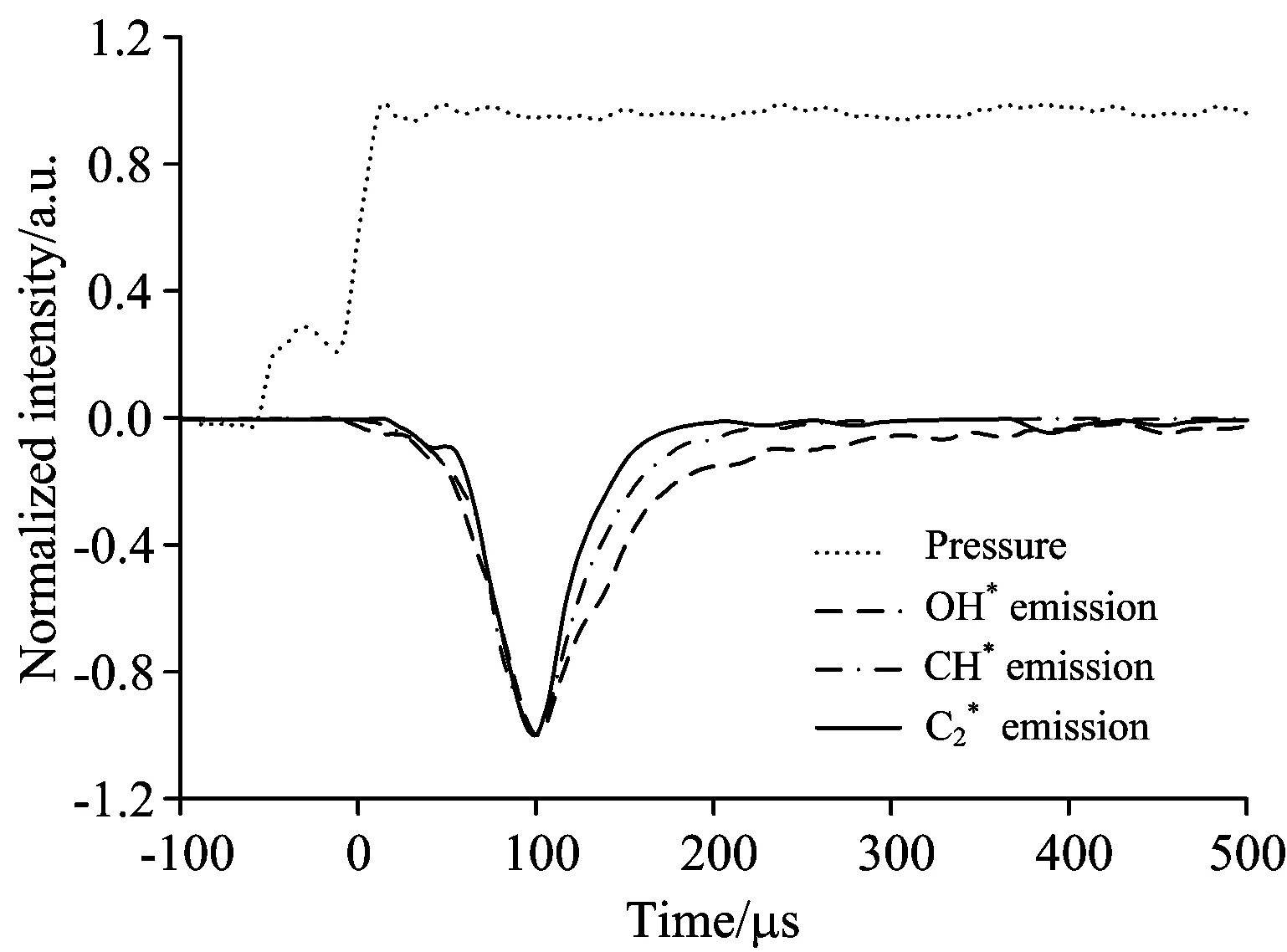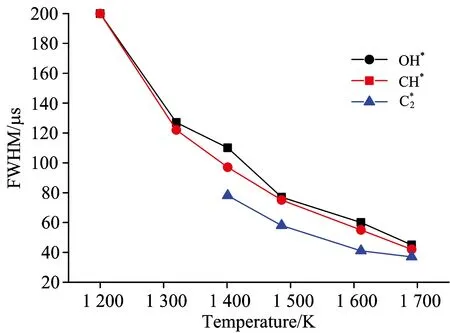发射光谱法研究甲基环己烷燃烧时激发态自由基时间历程
李有亮,何九宁,张昌华*,李 萍,李象远
1. 四川大学原子与分子物理研究所,四川 成都 610065 2. 四川大学化学工程学院,四川 成都 610065
发射光谱法研究甲基环己烷燃烧时激发态自由基时间历程
李有亮1,何九宁1,张昌华1*,李 萍1,李象远2
1. 四川大学原子与分子物理研究所,四川 成都 610065 2. 四川大学化学工程学院,四川 成都 610065

甲基环己烷;发射光谱;激发态自由基;时间历程
引 言
燃烧是一个复杂和剧烈的发光发热化学反应过程。对燃烧的检测,尤其是瞬态燃烧过程的检测能深入认识燃烧的本质。光谱技术具有响应速度快、非接触测量以及高灵敏度等特点,在燃烧诊断中已得到广泛应用。国内外科研工作者基于光谱理论提出并建立了多种燃烧激光光谱诊断技术,主要包括激光诱导荧光技术、拉曼光谱技术、激光吸收光谱技术等,在燃烧温度场和组分浓度场等参数测量中得到广泛的应用[1-2]。然而主动激光诊断技术都需要高性能的激光器设备,投资大,抗干扰能力弱,对环境要求高,同时由于光路和激光器波长的限制,此技术一般在线监测一种自由基,难以同时监测多个自由基。


1 实验部分


Fig.1 Schematic diagram of the experimental setup
2 结果与讨论
2.1 激发态自由基时间历程

为进一步探究甲基环己烷激发态自由基随点火温度的发光规律,实验时仅改变反射激波温度,测量了不同温度下自由基的瞬态发射光谱。图3实线给出了激波温度1 400~1 700 K时CH*和OH*自由基时间历程。在反射激波到达后,激发态自由基发光出现时间会随着温度的降低而推迟,点火温度每降低100 K,发光出现的时间会延长约一倍,这主要是因为温度越高,燃烧反应越迅速,分子越容易断键形成小的自由基。

Fig.2 Radical emission and pressure profiles of methylcyclohexane combustion at 1 600 K


Fig.3 Comparison of experimental profiles (solid lines) of OH*(a) and CH*(b) radicals with the predictions (dash lines) of a kinetic mechanism by Rotavera et al[11]

Fig.4 Full width at half maximum of emission profiles as a function of temperature



Fig.5 Relative peak intensities of OH*, CH* andradicals as a function of temperature
2.2 与机理预测的对比

3 结 论

[1] Vasu S S, Davidson D F, Hanson R K. Combustion and Flame, 2009, 156: 736.
[2] Mével R, Pichon S, Catoire L, et al. Proceedings of the Combustion Institute, 2013, 34: 677.
[3] Panoutsos C S, Hardalupas Y, Taylor A M K P. Combustion and Flame, 2009, 156: 273.
[4] Zhang T, Guo Q H, Liang Q F. Energy and Fuel, 2012, 26: 5503.
[5] Kopp M, Brower M, Mathieu O. Appl. Phys. B, 2012, 107: 529.
[6] Weber B W, Pitz W J, Mehl M. Combustion and Flame, 2014, 161: 1972.
[7] Cook R D, Davidson D F, Hanson R K. Proceedings of the Combustion Institute, 2009, 32: 189.
[8] Zhang C, Li P, Guo J, et al. Energy and Fuel, 2012, 26: 1107.
[9] Brockhinke A, Krüger J, Heusing M. Appl. Phys. B, 2012, 107: 539.
[10] Rotavera B, Dagaut P, Petersen E L. Combustion and Flame, 2014, 161: 1146.
[11] Rotavera B, Petersen E L. Fuel, 2014, 115: 264.
*Corresponding author
Research on the Time-Histories of Exited Radicals during the Combustion of Methylcyclohexane by Emission Spectroscopy
LI You-liang1, HE Jiu-ning1, ZHANG Chang-hua1*, LI Ping1, LI Xiang-yuan2
1. Institute of Atomic and Molecular Physics, Sichuan University, Chengdu 610065, China
2. College of Chemical Engineering, Sichuan University, Chengdu 610065, China

Methylcyclohexane; Emission spectrum; Excited-state radical; Time-history
Oct. 21, 2014; accepted Jan. 30, 2015)
2014-10-21,
2015-01-30
国家自然科学基金重大研究计划项目(91016002)资助
李有亮,1990年生,四川大学原子与分子物理研究所硕士研究生 e-mail: lyl3038296@163.com *通讯联系人 e-mail: zhangchanghua@scu.edu.cn
O657.3
A
10.3964/j.issn.1000-0593(2016)01-0011-04

